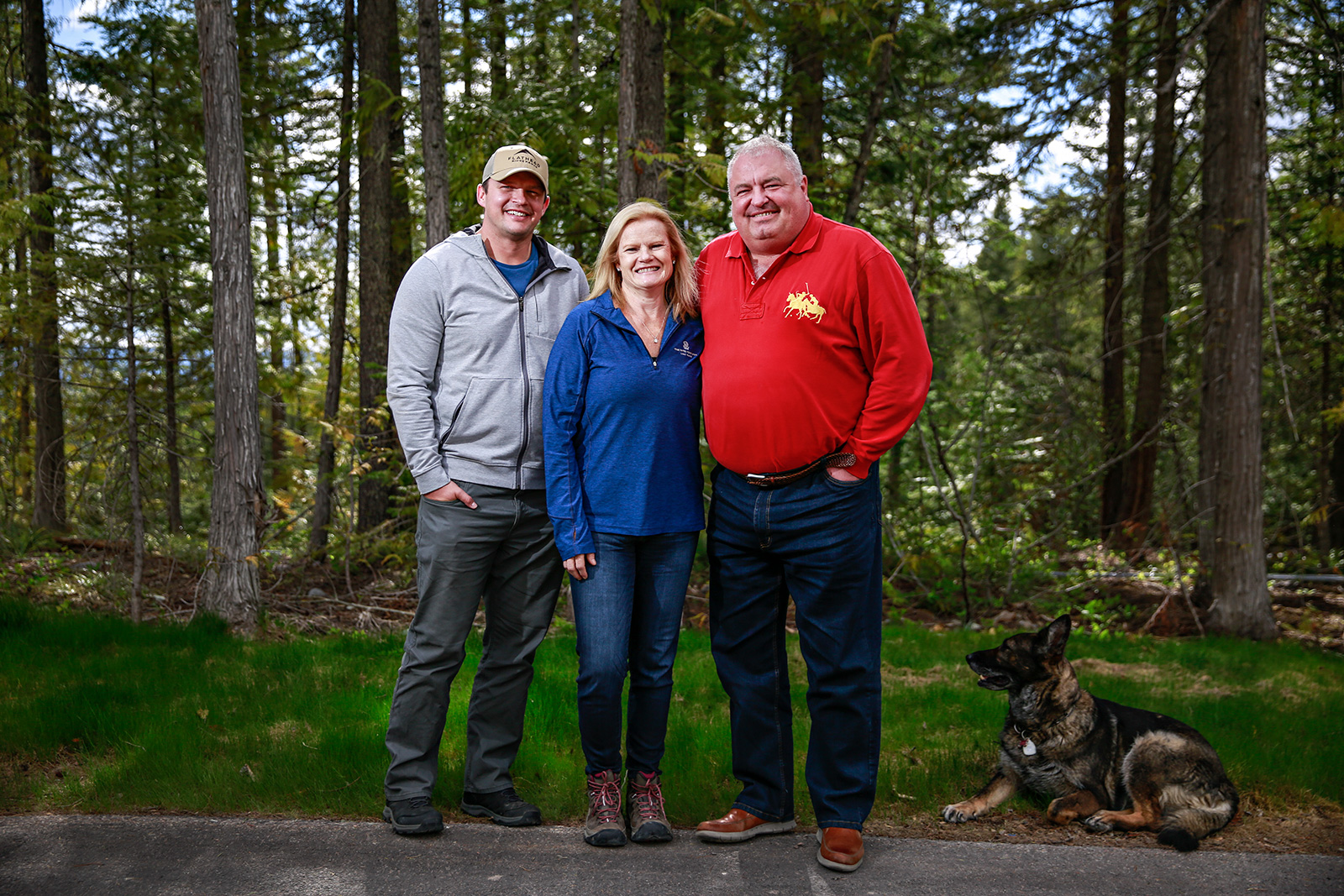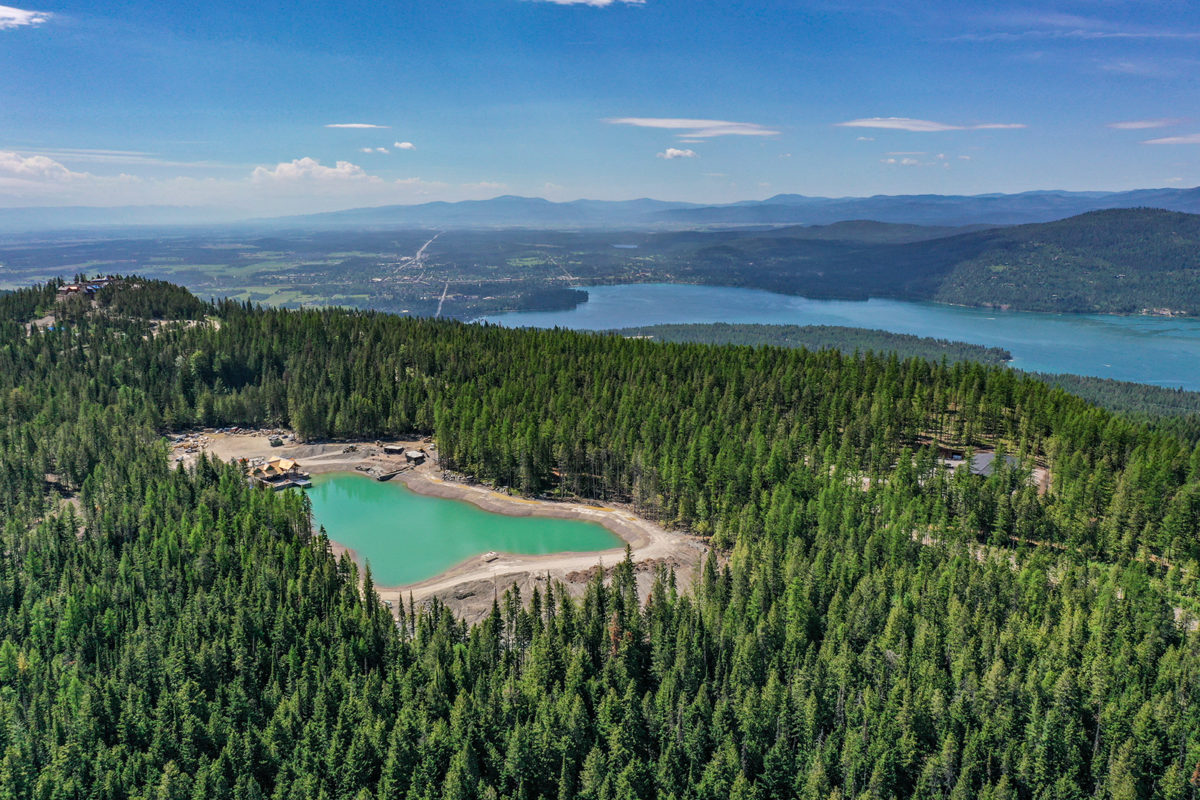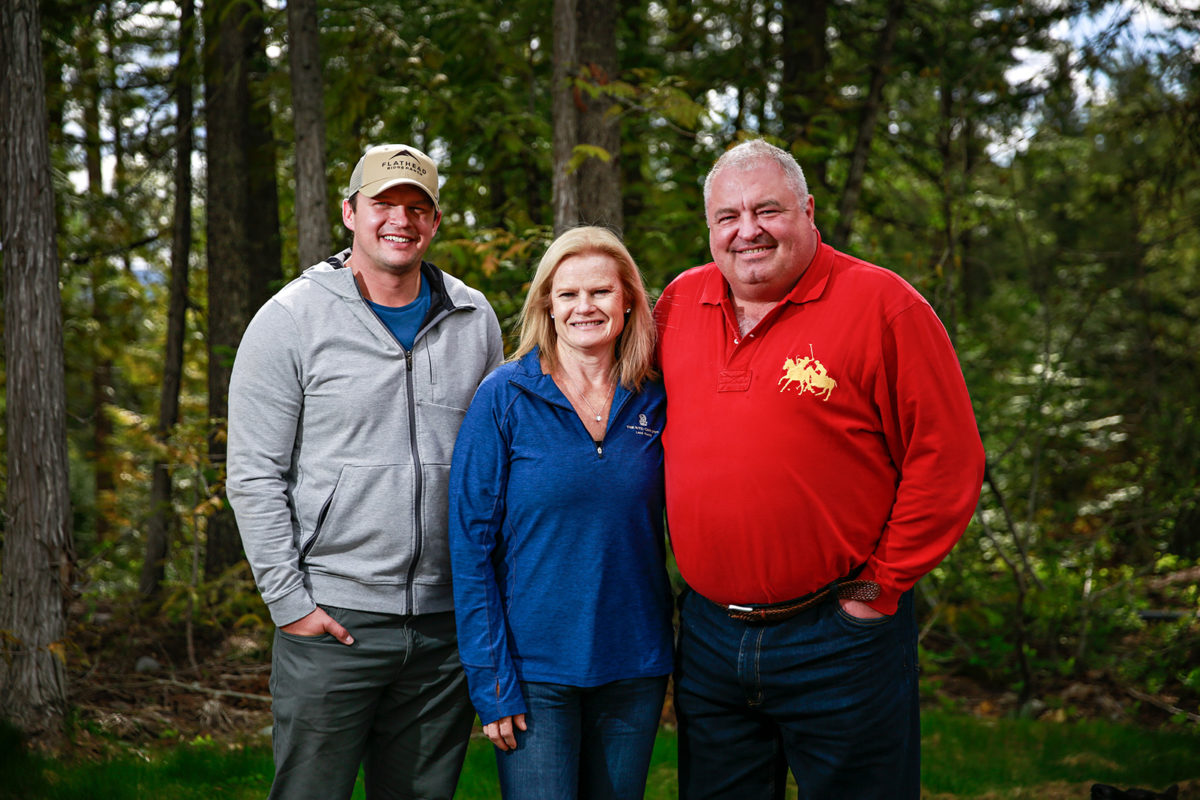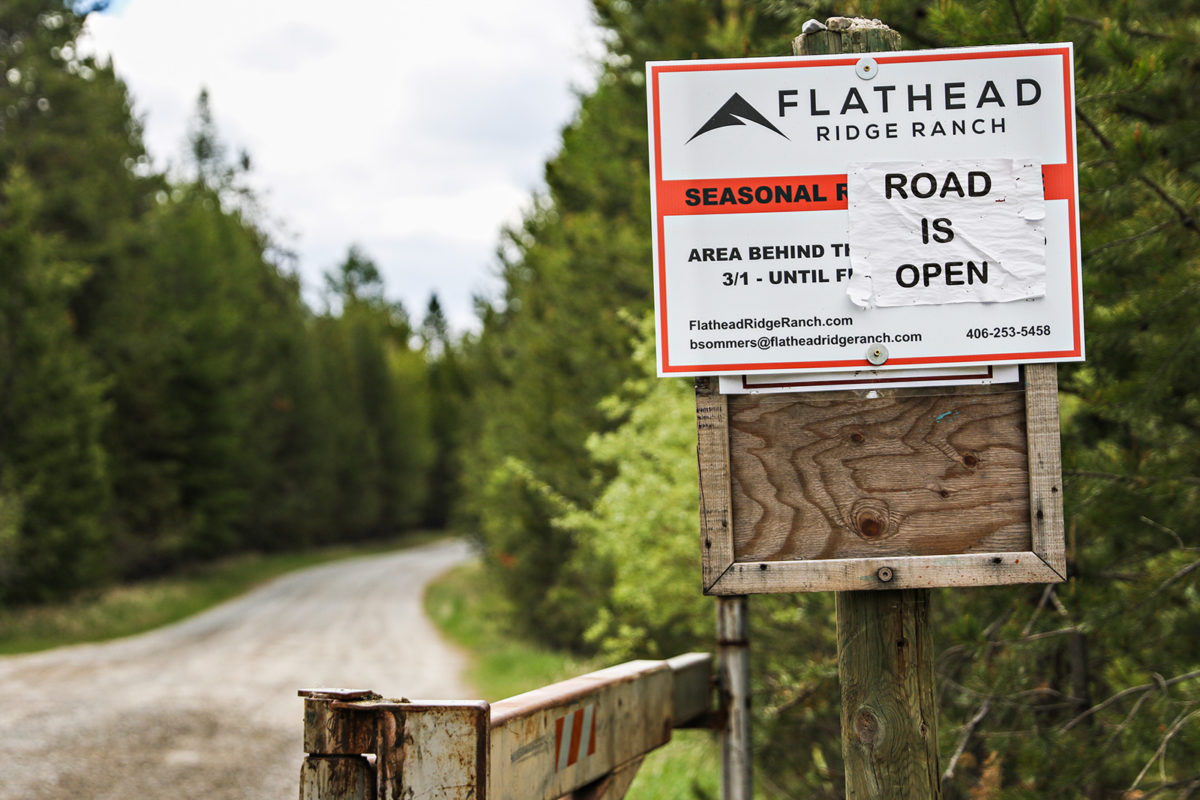Meet the Joneses
Since purchasing their dream property on Big Mountain, the self-made billionaires have expanded their land portfolio to include nearly one-fifth of all private land in Flathead County. Their aim isn’t to expand their business empire or build an inclusive resort, they say, but rather to create a family legacy and establish a reputation as good neighbors.
By Tristan Scott
At first blush, the Joneses appear to be settling right into their dream home on Whitefish’s Big Mountain, but as the Joneses can attest firsthand, appearances are often deceiving.
It takes time for a dream to become reality, and the Joneses’ is still under construction. In many ways, it’s a dream they’ve been building since high school.
The Joneses are Mark and Robyn, a pair of Alberta-born teenage sweethearts whose $2.1 billion self-made fortune recently began materializing in the Flathead Valley, most prominently on a 260-acre property adjacent to the Whitefish Mountain Resort ski area on Big Mountain, and through their high-profile purchase of nearly 126,000 acres of forested timberland west of Kalispell — land that, although privately owned for decades, generations of Montana families have hunted and fished under a succession of corporate owners with an open-gate policy.
Combined, the land acquisitions make the Joneses the proud owners of 18% of Flathead County’s private parcels, a staggering real estate portfolio that’s even more astounding when the couple explains their plans for the sprawling footprint.
“For the most part, we plan to leave it much the way it is,” said Mark Jones, chairman and CEO of Dallas-based Goosehead Insurance, who, along with his wife, the company’s founder, describes his Northwest Montana interests as “a family legacy investment,” separate from their lucrative business ventures and growing insurance empire.
Having essentially bootstrapped their way to financial success, the Joneses are sensitive to coming across as ostentatious, particularly in their newly adopted community. Still, their wealth — the fruits of their labor — is of a magnitude that’s difficult to obscure, and while they’re under no obligation to explain their intentions to the local public, they feel somewhat beholden, given the scope of their land purchase and the attention it’s drawn.
“One thing I want to be clear about is that we don’t have any plans for a large-scale residential or resort-type development of any kind,” he continued. “Our objective is conservation, so from the outside it won’t look any different. This is a family legacy investment, so even though it’s a lot of land it does not represent part of my investment portfolio or part of my business strategy to make money.”

On recent weekend visits to Whitefish from their home in Westlake, Texas, the couple has been staying at their estate manager’s residence off Big Mountain Road, a 3,800-square-foot Western ranch-style affair, situated at the foot of a long and winding drive leading to a real-life version of Xanadu. Outfitted with an equestrian complex, 11 miles of hiking, biking and ATV trails (each section of trail is named after one of the Joneses’ 15-soon-to-be-16 grandchildren), a 3-acre hand-built pond with a boathouse and waterslide tower, a park with tennis and basketball courts, and a 31,000-square-foot mega-mansion valued at $9.2 million, the compound truly is something out of a fantasy.
Again, the Joneses are reluctant to discuss the details of their opulent lifestyle at the risk of appearing garish, even if they are quite pleased with how the dream is coming together.
“This property is my Mona Lisa. It’s the property that I am most proud of. And I’m going to be most proud to leave behind,” Mark said. “It’s fine to make a lot of money, but at some point you ask yourself, ‘What is the money for?’ We want to use this to create opportunities for our family, to create memories and experiences. This place will be magical. We’re building waterslides that will be the biggest waterslides in Montana. The designers said they could build waterslides that were 60-feet tall, and I said, ‘They need to be 100 feet.’ When I do something, I do it right.”
“When we bought this place, it was a lot like coming home,” he added.
Originally from Lethbridge, Alberta, Mark and Robyn Jones married almost immediately after completing high school. Mark went to work driving truck at Robyn’s father’s fertilizer business before enrolling at the University of Alberta to earn his degree as a CPA and cut his teeth in finance.
By 1985, the Joneses were raising three children while chafing under the constraints of Mark’s scant salary, which, along with his innate ambition, prompted him to enroll at Harvard Business School. After graduating in 1991, he secured a partnership at Bain Capital, the private investment firm based in Boston, and the family’s lot improved, despite Mark’s dizzying travel schedule and Robyn’s growing restlessness.
“I was basically a stay-at-home mom raising six kids at that point,” Robyn recalls. “So I thought I would like to try to flip some houses.”
Early on in her foray into the real estate market, Robyn encountered frequent stumbling blocks in the form of insurance agents, which led her to pursue her license and become one herself, starting an agency in 2003.
Robyn’s fresh approach to the industry, as well as her emphasis on client interface as a separate function from sales, allowed her to make quick gains in a sector that seemed to be stagnating from complacency.
“It’s pretty remarkable what happens when you put your clients at the center of your service,” Robyn said.
By 2004, she’d convinced Mark to quit his job at Bain and join her in the insurance enterprise, a move that didn’t sit well with their friends and family.
“People thought I was insane,” Mark said, noting that he didn’t pay himself for the first two years as the new CEO of the business, finally opting in for a salary of $35,000.
What began as an offshoot of Robyn’s frustrations with the real estate market, where the obstacle of new buyers procuring homeowner insurance kept her from closing deals, has grown into a company with 900 employees, 500 franchises, nine corporate offices and, since taking it public in 2018, a 45% annual growth rate.
On paper, Mark is the chairman and CEO and Robyn is vice chairman, but the couple acknowledges that Robyn’s business acumen was the catalyst for their wealth.
“This is someone who had been a stay-at-home mom for 20 years, with no college education, and she decided to create a business and convince her hotshot Bain partner husband to leave the company and come aboard,” Mark said. “And that’s a pretty audacious proposal.”

Today, Mark and Robyn are approaching 60. Their six children — five daughters and one son — are all grown and raising broods of their own. A 16th grandchild is on the way.
To that end, the Joneses had been thinking a lot about what kind of legacy they’d like to leave behind, something for their family to enjoy, somewhere that felt closer to their salt-of-the-earth Alberta upbringing, before the sky lost its limits.
“As kids, we came to the Flathead Valley on vacation,” Mark said. “We’d drive up Logan Pass to go skiing every year and spend time in Whitefish.”
Still, when they started thinking seriously about building a dream home, Whitefish wasn’t the immediate choice.
“We’d been talking about places for a mountain home,” Mark said, but the luxury resorts of Beaver Creek and Bachelor Gulch weren’t the right fit. “We toyed with the Yellowstone Club, but that wasn’t really us. Whitefish is a much better fit for our DNA.”
After learning that 260 acres near Big Mountain was for sale, they decided to visit the property.
“There’s no photograph that can compare. Nothing that captures the beauty of it,” Mark said during a recent interview on the property. “Robyn and our oldest daughter went for a walk and five minutes later I was shaking hands with [the seller]. That’s how quickly we became the owners of our dream.”
“But something I’ve always wanted was to find a place that is completely, utterly quiet,” Mark continued. “A place that truly allows you to get away from it all. I wanted a vacation home from my vacation home.”
That quiet place materialized in the form of Pat Patton, the garrulous president of Georgia-based Southern Pine Plantations, a timber and real estate investment firm that in January 2020 purchased 630,000 acres of land from Weyerhaeuser Company, following that timber giant’s 2016 merger with Plum Creek Timber Company, the one-time industry leader whose name is synonymous not only with Northwest Montana’s logging legacy, but also its rich array of camping, fishing and hunting spots — the expression “old Plum Creek land,” for example, is baked into the colloquial lexicon.
By the time Southern Pine Plantations (doing business as SPP Montana) bought the land from Weyerhaeuser for $145 million in cash, decades of logging pressure had reduced the timber supply; because the parcels now hold a much smaller inventory of merchantable saw logs than they once did, speculation was rampant about whether the land would be sold off for development piecemeal style.
At the time of the sale to SPP, numerous sportsmen and wildlife-conservation organizations had been working on a pair of land conservation deals with Weyerhaeuser to place 230,000 acres of prime wildlife habitat and timberland into easements, which would provide public access in perpetuity, and which SPP Montana pledged to honor. But the company was also looking to turn a profit, and it unloaded an additional 291,000 acres of its newly acquired land to Green Diamond Resources, a timber company that has also vowed to make access and conservation top priorities.
That left SPP Montana holding a balance of roughly 130,000 acres of timberland in a market that is primed for development.

Enter the Joneses.
“Pat said, ‘I think we can find something for you,’” Mark recalled. “I knew it was a once-in-a-lifetime opportunity to acquire that much contiguous acreage in a place as special as Northwest Montana, a place that already felt like home.”
Dubbed Flathead Ridge Ranch LLC, the family will continue to manage the existing timber supply, but the primary goal will be to conserve the land, according to the Joneses as well as Ryan Langston, the couple’s son-in-law, who functions as president of Flathead Ridge Ranch LLC, as well as general counsel of Goosehead Insurance.
Despite the succession of corporate sales in recent years, most of the Flathead Ridge Ranch property has remained accessible to the public for recreation through a cooperative management agreement between the owners and Montana Fish, Wildlife and Parks (FWP), the state agency whose block management program was voluntarily renewed for decades, allowing access to the private parcels in exchange for a patrol presence by state game wardens, although only during hunting season.
To that end, the revelation that the Joneses had purchased such a broad swath of private land with a rich history of public access elicited an emotional response from some segments of the region’s vibrant hunting, fishing and outdoor recreation community. To assuage those concerns, the new owners have promised to maintain public access on sizable portions of the property, including the tracts of land flanking Hubbart Reservoir, a 480-acre impoundment rimmed by cliffs and pine forests, and which serves as a popular ice-fishing destination in winter, as well as an attraction to campers during most summer weekends. The property then runs east to Lake Mary Ronan, where the Joneses are allowing non-motorized, non-hunting related public access, such as hiking, biking and horseback riding, while continuing to allow access at other popular points along Red Gate Road, Hubbart Dam Road and Browns Meadow Pass Road, all of which were included in the sale.
To codify their pledge of continued access, the Joneses enrolled 106,052 acres of the property into FWP’s block management program.
Still, the specter of restricted land access touched a nerve among local sportsmen groups, which is testament to a growing anxiety over preserving a way of life that some view as eroding under pressure from out-of-state interests, and with them a rise in demand for outdoor recreation, including hunting.
“The local community has been wonderfully welcoming to us, truly, but we have encountered some hostility or belligerence from people who don’t subscribe to what we’re trying to do,” Mark said.

In an effort to broker better relationships with the public, the Joneses hired Brian Sommers, who spent his career working as a game warden and investigator for FWP. Sommers knows the property well, and he possesses a unique understanding of Northwest Montana’s culture of outdoor recreation, which has all the sanctity of a birthright to generations of hunters who call the area home.
“The issue that some people are struggling with is that, in their minds, this has always been public land, even though it’s been privately owned for decades,” Sommers said. “There have always been rules in place in exchange for the public’s ability to access this land, but whether those rules were strictly enforced is another matter.”
According to Sommers, the conditions of use under Flathead Ridge Ranch ownership don’t involve any sweeping changes; rather, he’ll be enforcing rules and regulations that have always been part and parcel to the access agreement.
“From our perspective, we’re pretty much allowing the same uses that have always been allowed here,” Sommers said. “We’re clamping down on off-road vehicle use, which we want to curtail, and we are limiting camping to a maximum of seven days to prevent squatting. We’re prohibiting campfires and recreational shooting, but those are the only major changes.”
Not everyone is immediately receptive to that line of reasoning, however, and Sommers said he’s invested untold hours having conversations with community members about the new developments.
“It’s like an open wound right now, and people are extremely sensitive to change,” Sommers added. “It’s going to take time to heal, but I think once people realize that most of what they want to do they can still do, the emotions will simmer down.”

Jim Williams, FWP’s regional supervisor in Northwest Montana, said access to the property has always hinged on the public’s stewardship, which is more critical now than ever. Williams said he’s encouraged by his interactions with the Joneses, as well as by the family’s understanding of the region’s outdoor heritage and values, and their decision to enter into a cooperative management agreement with FWP. Nevertheless, the public needs to understand that it’s a privilege to access the private parcels, and not an inherent right, Williams said.
“What everyone needs to realize is that this is private land and it has been private land for a very long time,” according to Williams. “So people need to be extremely respectful when they are on these lands, particularly surrounding some of the new rules being developed.”
As the Joneses settle into their adopted community, the last thing they want to do is create acrimony, or turn people off by appearing “ostentatious” or “arrogant,” Mark said. But they won’t endure abuse, and there’s a limit to how accommodating they’ll be if the public doesn’t respect the ground rules.
“We’ve made a little bit of money, but we’re still normal people,” Mark said. “I don’t feel like an out-of-state billionaire. I don’t feel like a rich guy from Texas buying up all the land. I feel like a guy from Lethbridge, Alberta, who took some risks and did well for his family. I feel like a guy who’s coming home.”